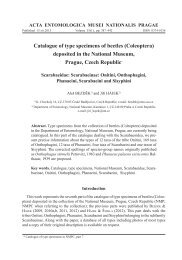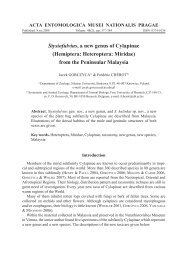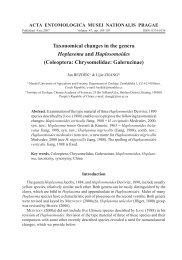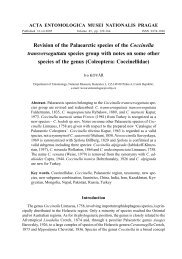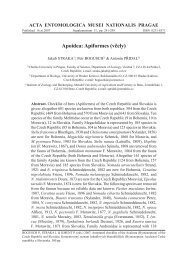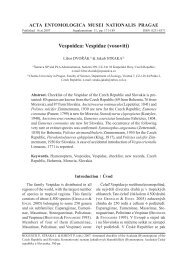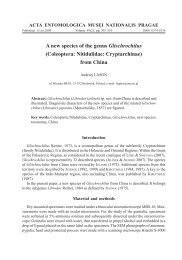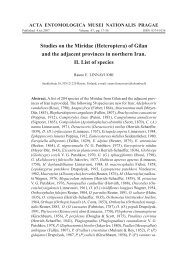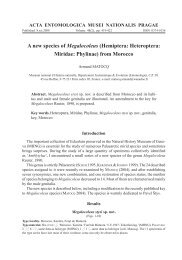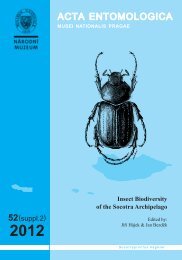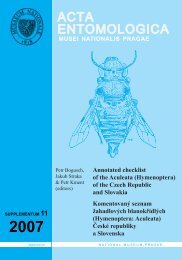Hemiptera: Heteroptera: Aradidae - Acta Entomologica Musei
Hemiptera: Heteroptera: Aradidae - Acta Entomologica Musei
Hemiptera: Heteroptera: Aradidae - Acta Entomologica Musei
You also want an ePaper? Increase the reach of your titles
YUMPU automatically turns print PDFs into web optimized ePapers that Google loves.
34<br />
HEISS & BAŇAŘ: A new apterous Tiomanaptera from Malaysia (<strong>Aradidae</strong>)<br />
Material and methods<br />
The specimen this study is based on is preserved in the Muséum d’Histoire Naturelle de<br />
Geneve (MHNG). Incrustations obscuring the body were removed, and the body was cleaned<br />
to study its structures. Colour photographs (Figs 1–4) were taken by Leica MSV266. Drawings<br />
were made using stereoscopic microscope SZP 11 ZOOM.<br />
Measurements, given in milimeters, were taken with a micrometer eyepiece.<br />
A slash (/) separates the lines when citing the text on the labels attached to the specimen.<br />
Abbreviations used: deltg = dorsal external laterotergite (connexivum), mtg = mediotergite.<br />
The following specimen was studied and figured for the comparative purposes:<br />
T. malickyi Heiss, 2010: (MHNG): ‘AS-WM07/7 W-Malaysia / Tioman Island, path from / Kg. Paya to Gunung<br />
/ Kajang, 200-600m, / 02°46‘84‘‘N, 104°07‘63‘‘E / 6.-7.VI.2007, leg. A. Schulz. / AS-WM07/7’.<br />
Taxonomy<br />
Tiomanaptera schwendingeri sp. nov.<br />
(Figs 1, 3, 5, 6)<br />
Type locality. Malaysia, Terengganu State, Pulau Perhentian Besar, trail across island from Teluk Pauh to Teluk<br />
Dalam, 5°53′51″N 102°44′53″E), 50–100 m a.s.l.<br />
Material examined. HOLOTYPE: , ‘THMA-08/01: W- / Malaysia: Terengganu / State, Pulau Perhentian / Besar, trail<br />
across island, / from Teluk Pauh to Teluk / Dalam (5°53’51’’N / 102°44’53’’E), 50-100m / (evergreen rainforest), 2- /<br />
4 VI 2008, leg. P. Schwendinger THMA-08/01’; printed label. This specimen is designated as holotype and labelled<br />
with printed red label: ‘HOLOTYPE / Tiomanaptera / schwendingeri sp. nov. / des. E. HEISS & P. BAŇAŘ 2013’.<br />
Deposited in MHNG. Antennal segments III and IV on left antenna are missing.<br />
Description. Apterous female of medium size (5.1 mm); surface of body rugose and glabrous,<br />
colouration piceous brown; middle and hind femora with preapical spines.<br />
Head. Including neck distinctly longer than width across eyes (1.35/0.75 mm); clypeus<br />
embraced by anteriorly contiguous, laterally expanded genae, reaching 0.5 antennal segment<br />
I; antenniferous lobes directed anterolaterally, apex rounded; antennae with segment I thickest<br />
and curved, II thinner and shorter than segment I, III thinnest and longest, IV fusiform,<br />
antennal formula (longest segment first): III-I-IV-II. Eyes oval, postocular lobes granulate,<br />
converging to neck; neck long and cylindrical; vertex raised medially, flanked by 2 (1+1)<br />
oval impressions. Rostrum arising from a slit-like atrium, shorter than head, rostral groove<br />
deep with carinate borders, closed posteriorly.<br />
Pronotum. Rectangular, twice as wide as long (1.3/0.65mm); consisting of a narrower ring<br />
like anterior collar which is triangularly produced posteriorly and separated from posterior<br />
lobe by a deep suture; lateral margins of posterior lobe parallel, anterolateral angles with a<br />
distinct tubercle, surface with rugosities, granulate on lateral lobes; posterior margin delimited<br />
by a transverse, slightly convex carina separating it from mesonotum.<br />
Mesonotum. Median rhomboidal plate rugose at base, smooth and raised posteriorly;<br />
lateral sclerites consisting each of a small oval elevation and raised lateral lobes with rugose<br />
surface, fused to metanotum, separated by a thin suture.<br />
Metanotum. Split medially by the triangular projection of mesonotal elevation, which<br />
reaches anterior margin of mtg I+II, into two lateral triangular sclerites, their surface smooth<br />
on inner angle and rugose on lateral lobes.



